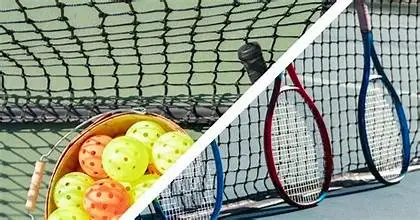
Are you an avid pickleball player? Have you ever wondered what is a delaminated pickleball paddle and how it can affect your game? Look no further, because this ultimate guide is here to provide you with all the answers.
Delamination, a common issue in pickleball paddles, occurs when the layers of the paddle separate, causing a loss in performance. Understanding the science behind delamination is crucial in recognizing and preventing this problem.
In this guide, we will delve into the impact of delamination on your game, teach you how to recognize the signs of a delaminated paddle, and provide you with tips to prevent it from happening in the first place.
Key Takeaways
- Continuing to use a delaminated pickleball paddle has pros such as being usable for casual play, saving money in the short term, and allowing for more time to decide on next steps.
- Repairing a delaminated pickleball paddle has pros such as the possibility of restoring the paddle, being a cost-effective option, and allowing for continued use of a familiar paddle.
- Purchasing a new pickleball paddle has pros such as ensuring optimal condition, a wide range of options available, and the potential for longer durability and lifespan.
- When dealing with what is a delaminated pickleball paddle, it is important to consider personal preferences and circumstances, prioritize personal needs and priorities, and make an informed decision based on the pros and cons of each option.
The Science Behind Delamination
The science behind delamination in pickleball paddles involves the separation of multiple layers of materials, such as carbon fiber, fiberglass, and polymer. This separation can occur due to excessive use, impact, or manufacturing defects.
Delamination is a common issue in paddle construction, particularly in thermoformed carbon paddles. When the layers of materials begin to separate, it creates a trampoline effect, which can significantly affect the performance of the paddle. This trampoline effect reduces the control and precision of shots, as the paddle loses its rigidity and responsiveness.
However, delamination can also be a sign of a well-used paddle. Some players prefer paddles that have a slight delamination because it can provide a softer feel and increased power. It’s important to note that excessive delamination can compromise the structural integrity of the paddle and render it unusable.
The Impact on Performance
The impact on performance when a pickleball paddle becomes delaminated is significant. The compromised structure hinders your ability to generate power, control your shots, and maintain consistency during gameplay.
Delamination refers to the separation of the layers that make up the paddle, which can occur due to various factors such as age, poor manufacturing, or excessive use. This controversy surrounding pickleball paddle delamination stems from its negative impact on performance and potential safety concerns.
When a pickleball paddle becomes delaminated, its power output diminishes significantly. The separated layers create gaps and weak points in the paddle, reducing the transfer of energy from your swing to the ball. As a result, your shots lack the necessary force to hit the ball with power, making it harder to generate winning shots or put your opponents on the defensive.
Moreover, delamination affects your ability to control the ball accurately. The compromised structure of a delaminated paddle makes it difficult to predict the ball’s trajectory and adjust your shots accordingly. This lack of control can lead to missed opportunities and errors in your gameplay, ultimately affecting your overall performance on the court.
Consistency is another key factor impacted by delamination. As the layers of the paddle separate, the paddle’s response to your swing becomes inconsistent. This inconsistency can make it challenging to execute shots with the same level of precision and timing, making it harder to maintain a consistent gameplay strategy and outmaneuver your opponents.
In addition to the performance issues, there are also safety concerns associated with using a delaminated paddle. The separated layers may cause injury during play, either by splintering or by creating sharp edges that can cut or scrape players. Consequently, many tournaments and leagues consider delaminated paddles to be illegal, as they pose a risk to players’ safety.
Recognizing What Is A Delaminated Pickleball Paddle
Regularly inspecting your pickleball paddle is crucial to ensure optimal performance and safety on the court. By checking for signs of delamination, such as visible separation of layers, a hollow sound when tapping the paddle, or a decline in performance, you can address any issues before they worsen.
Don’t overlook the importance of regular paddle inspection, as it can help you identify potential problems and extend the lifespan of your paddle.
Importance Of Regular Paddle Inspection
Take a moment to examine your paddle, as regularly inspecting it is crucial for optimal performance and safety. Delamination can occur over time due to wear and tear, impacting the paddle’s performance and potentially posing a safety risk.
To help you understand the importance of paddle inspection, consider the following table:
| Type of Paddle | Signs of Delamination | Action Required |
|---|---|---|
| Tickle My Pickleball | Soft spots or sagging in the paddle surface | Replace paddle immediately |
| Six Zero Paddle | Visible cracks or separation in the layers of the paddle | Seek professional repair or replace |
| Vatic Pro | Loss of rigidity or unusual vibration during play | Inspect paddle more frequently, consider replacing |
Regular paddle inspection is essential to catch delamination early on and prevent further damage. By taking the time to examine your paddle regularly, you can ensure its longevity and maintain optimal performance.
Preventing Delamination
To minimize the risk of delamination:
- Avoid excessive paddle-to-paddle contact.
- Store your paddle in a climate-controlled environment.
- Use protective paddle covers.
Delamination occurs when the layers of a pickleball paddle separate, leading to a loss of performance and potentially compromising the paddle’s integrity. Excessive paddle-to-paddle contact can cause unnecessary stress, increasing the chances of delamination. Try to minimize contact by using proper technique and avoiding unnecessary clashes.
Storing your paddle in a climate-controlled environment is crucial. Extreme temperatures can weaken the adhesive bond between the layers, making delamination more likely. Keep your paddle in a cool, dry place, away from direct sunlight or excessive humidity.
Using protective paddle covers can go a long way in preventing delamination. These covers provide an extra layer of protection, shielding your paddle from accidental impacts and environmental factors.
Dealing with Delaminated Paddles
Now that you understand the importance of preventing delamination in your pickleball paddle, let’s discuss what options are available to you if your paddle does become delaminated. Don’t worry, there are several routes you can take to get back in the game.
One option is to contact the manufacturer and inquire about their warranty information. Many paddle manufacturers offer warranties that cover delamination, so you may be able to get a replacement paddle at no cost or a discounted price. This is a great option if your paddle is still under warranty.
If your paddle is no longer under warranty or you prefer to explore other avenues, you can seek professional repairs. There are paddle repair specialists who can fix delaminated paddles and restore them to their original condition. This option allows you to keep using your favorite paddle without having to purchase a new one.
Lastly, if neither of the above options are viable or you simply want to upgrade your paddle, you can always replace the delaminated paddle with a new one. There are numerous paddles on the market, each with their own unique features and benefits, so you can find one that suits your playing style and preferences.
Conclusion
In conclusion, the best course of action for dealing with a delaminated paddle is ultimately up to you. After considering the options and understanding the potential risks and benefits, you can make an informed decision based on your own preferences and circumstances.
One option is to continue using the delaminated paddle. While it may still be usable for casual play or practice sessions, keep in mind that the delamination could worsen over time and eventually render the paddle unusable. If you choose to continue using it, be prepared for the possibility of needing to replace it in the near future.
Another option is to repair the delaminated paddle. This can be done through various methods, such as using epoxy or adhesive to reattach the layers of the paddle. However, it’s important to note that paddle repairs are not always successful and may not restore the paddle to its original condition. Additionally, attempting a repair yourself may void any warranty on the paddle, so it’s essential to consider the potential risks before proceeding.
If you prefer a hassle-free solution, you may opt to purchase a new paddle altogether. This ensures that you have a paddle in optimal condition and eliminates any concerns about the delamination affecting your performance on the court.
Frequently Asked Questions
How long does it typically take for a pickleball paddle to delaminate?
It typically takes a pickleball paddle several years of regular use before it starts to delaminate. However, the lifespan can vary depending on the quality of the paddle and how often it is used.
Can delamination be repaired, or is it necessary to purchase a new paddle?
Delamination can be repaired, but it’s not always necessary to purchase a new paddle. Depending on the extent of the damage, you can fix it with epoxy or take it to a professional for repair.
Are all pickleball paddles susceptible to delamination, or are some brands more prone to it than others?
Some brands of pickleball paddles are more prone to delamination than others. Not all pickleball paddles are equally susceptible to delamination, so it’s important to choose a brand that has a good reputation for durability.
What are the signs of delamination that players should look out for during gameplay?
During gameplay, look out for signs of delamination in your pickleball paddle. These may include a soft or spongy feeling, a hollow sound when striking the ball, visible cracks or bubbles, and a decrease in performance.
Are there any specific care instructions that can help prolong the lifespan of a pickleball paddle and prevent delamination?
To prolong your pickleball paddle’s lifespan and prevent delamination, follow these care instructions: avoid excessive heat or cold, store it in a protective cover, clean it with a mild soap and water, and avoid hitting the ground or other hard surfaces.





